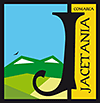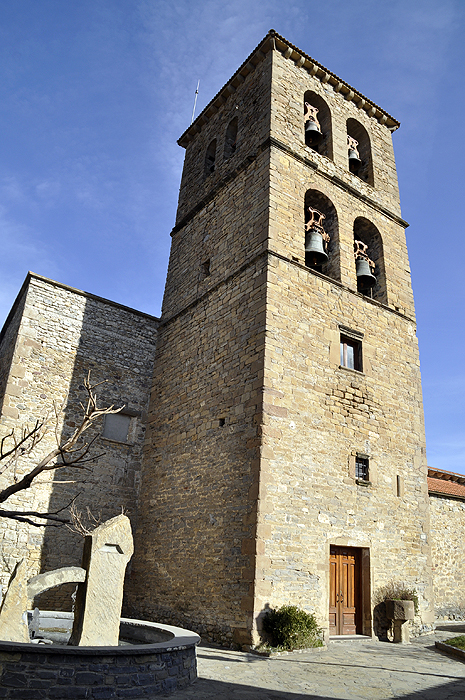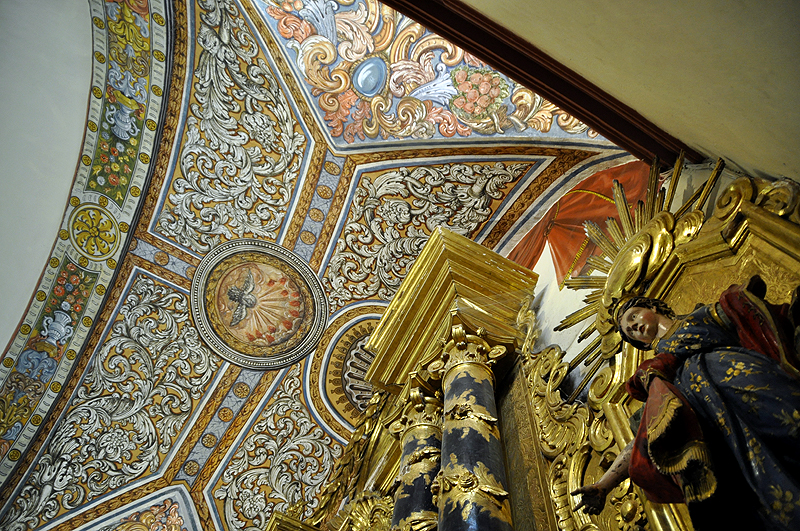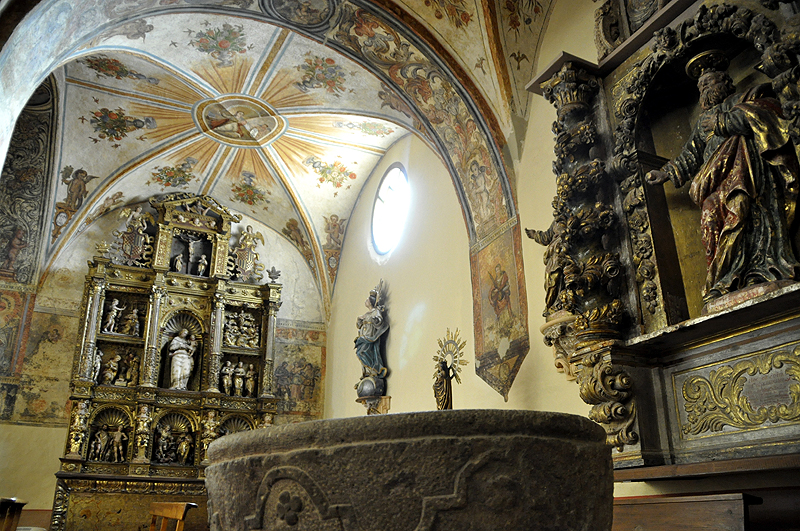Santa Cilia. Church of El Salvador. 18th century
The existing church of El Salvador is made of stone and was built in the 18th century on top of another church dating from the 14th century and also dedicated to El Salvador. Existing documents dating from 1336 mention the original temple. The one we see now conserves some of the original features, for example the bell tower (built in 1646) and a beautiful Gothic doorway sheltered by a characteristic portico. Access to the interior is through two doorways. One of these carries the inscriptions “IHS” (“Iesus Hominum Salvator”-“Jesus Saviour of Men”) and “abadía” (“Abbey”)
Although it is a simple building, it has a number of artistic and architectural elements of great interest. Its single nave structure was extended to include two side chapels, one on either side of the building, giving it the appearance of a Latin cross. It also has a choir gallery at the western end which until 1930 communicated with La Clavería Palace, an adjacent 13th century building which was the seat of the Santa Cecilia Priory and had formed a part of the monastery of San Juan de la Peña estate for many centuries.
The interior is remarkable for its painted vaults, decorated in the 18th century with ornaments of consoles, leaf motifs and cherubs. The main altarpiece dates from the end of the same century and is a mixed piece of painting and sculpture, clearly modelled on some works in the monastery of San Juan de la Peña. This is what emerges from the 1767 order documents for the artist Braulio Gonzalez, from Zaragoza. These mention the “French style” to define the creative style required. The paintings on canvas depict the Ascension and the Eternal Father.
Another piece that deserves a mention is the altarpiece of the Virgin of the Rosary, created in 1565 by Jorge Erigert of Flanders, an artist that lived in Sangüesa at that time. The work is carved in wood following the aesthetic criteria of the period known as the “first Renaissance” and the sculptures show scenes of the life of the Virgin.
A Romanesque figure of the Virgin from the 13th century has also survived. It shows the Virgin Mary, crowned and sitting on a throne, with the Baby Jesus sitting on her lap.
Although it is a simple building, it has a number of artistic and architectural elements of great interest. Its single nave structure was extended to include two side chapels, one on either side of the building, giving it the appearance of a Latin cross. It also has a choir gallery at the western end which until 1930 communicated with La Clavería Palace, an adjacent 13th century building which was the seat of the Santa Cecilia Priory and had formed a part of the monastery of San Juan de la Peña estate for many centuries.
The interior is remarkable for its painted vaults, decorated in the 18th century with ornaments of consoles, leaf motifs and cherubs. The main altarpiece dates from the end of the same century and is a mixed piece of painting and sculpture, clearly modelled on some works in the monastery of San Juan de la Peña. This is what emerges from the 1767 order documents for the artist Braulio Gonzalez, from Zaragoza. These mention the “French style” to define the creative style required. The paintings on canvas depict the Ascension and the Eternal Father.
Another piece that deserves a mention is the altarpiece of the Virgin of the Rosary, created in 1565 by Jorge Erigert of Flanders, an artist that lived in Sangüesa at that time. The work is carved in wood following the aesthetic criteria of the period known as the “first Renaissance” and the sculptures show scenes of the life of the Virgin.
A Romanesque figure of the Virgin from the 13th century has also survived. It shows the Virgin Mary, crowned and sitting on a throne, with the Baby Jesus sitting on her lap.
Also consult...
¤ Monuments
¤ Nature
¤ Villages
¤ Sport
¤ Tourist Offices
¤ Museums and Interpretation Centres
Guided tours 360°
Ciudadela de Jaca
[Español] · [Inglés]
Monasterio de San Juan de la Peña
[Español] · [Inglés]
Fort du Portalet
[Español] · [Francés]
follow us in...




 Comarca de La Jacetania
Comarca de La Jacetania
C/ Ferrocarril s/n 22700
JACA (Huesca)
T. (+34) 974 356 980
F. (+34) 974 355 241
:: Oficina de Turismo de JACA: 974 360 098
:: Oficina de Turismo de CANFRANC:
974 373 141
Site Map









